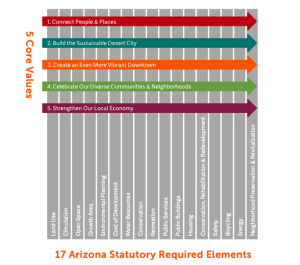Municipalities experiencing growth are changing their land developmental strategies in response to the effects of climate change. This is especially true for desert cities that are built on landscapes not meant to maintain large populations. They are challenged, particularly, by record-breaking heat and declining water resources.
This issue is particularly familiar to Phoenix, Arizona. In 1968, President Lyndon B. Johnson launched the Central Arizona Project to nurse water into the young city. This initiative feeds water through a 336-mile canal system from the Colorado River into Phoenix’s water reserves. However, the Colorado River has been facing a 20-year drought and as record-breaking heat continues, the river’s water levels are predicted to diminish as much as 25% in the future. Nevertheless, with unique challenges such as these can come unique resolutions.
Phoenix is a leader in sustainable development. The city was one of the first to achieve Platinum status, the highest level of certification under the LEED for Cities and Communities rating system. LEED (Leadership in Energy and Environmental Design) for Cities and Communities, created by the U.S. Green Building Council, is a framework that allows cities to track their sustainability objectives. This framework promotes sustainable land use strategies while allowing cities to develop. In accordance with the standardized scorecard, municipalities can achieve certified, silver, gold, or platinum status. This scorecard rates the cities on integrative processes such as natural systems and ecology, transportation and land use, water efficiency, energy and greenhouse gas emissions, materials and resources, and quality of life.
To marry all of these processes, Phoenix adopted the Vision of the Connected Oasis in its 2015 General Plan. This concept envisions Phoenix interconnected by pedestrian paths and open space networks. It addresses Phoenix’s transportation and water networks while mitigating the effects of climate change by using carbon sequestration and transportation alternatives. The vision aims to enhance the quality of life by improving public health, environmental health, and prosperity within the city.
Not only is Phoenix connecting people to the city, but it is also connecting its core values to Arizona statutory requirements.

To accomplish this incredible feat, Phoenix uses seven tools:
- Tree and Shade Master Plan which addresses plans on implementation);
- Seventh Avenue Urban Mainstreet Overlay (which addresses the enforcement of existing codes and the creation of new ones);
- The city-wide health initiative FITPHX (which addresses the operation of new and existing programs);
- the Bond Program (which addresses financing);
- Adopt-A-Street (which addresses developments and partnerships that can be used to achieve the goals);
- Reimagine Phoenix (which addresses community outreach); and;
- Volunteer Phoenix (which addresses activities citizens can do now to implement the goals).
In short, Phoenix has one vision, to create a connected oasis, three challenges they want to address (public health, environmental health, and prosperity), five core values that describe the future of the city (see the chart above), and seven strategic tools that allow it all to happen (as stated in the paragraph above).
Branching off of the goals associated with the Vision of the Connected Oasis, Phoenix set a series of objectives to be reached by 2050 for transportation, waste, water stewardship, building and land use, parks, preserves, open spaces, clean air, and local food systems. For example, by 2050 Phoenix will achieve a visibility index of good or excellent on 90% of days or more. To do this, it has implemented stringent rules and regulations on air pollution and dust control programs. It also created pathways and public transit systems to further the values of the Vision of the Connected Oasis. By 2050, Phoenix will provide a clean and reliable 100-year supply of water by developing conservation programs, continuing the use of its wastewater infrastructure, and funding projects for water innovation. In addition, in 2008, voters renewed the Phoenix Parks and Preserve Initiative for 30 more years. This initiative sets aside one cent of its sales tax for every $10 of purchases. The money will be used to improve and renovate existing parks and to expand and improve the city’s desert preserve system. (See General Plan). These regulations and initiatives allow the city to be harmonious with the Sonoran Desert.
These goals are quite intense, but they are feasible. To create this revolutionized desert city, it will take persistence among leaders and compliance among citizens. However, Phoenix is on the right track and that can be seen through its earning of the LEED for Cities and Communities platinum status.
This article is part of a series from the Land Use Law Center that explores how local governments can implement Climate Resilient Development (CRD) as defined in the Sixth Assessment Report of the IPCC. CRD requires innovative reform of land use planning and regulation by local governments. The series presents and analyzes numerous local laws and policies capable of adapting to and mitigating climate change to create equitable and sustainable neighborhoods, achieving “sustainable development for all.”
Author: Hannah Gaudet, 1L Land Use Scholar
